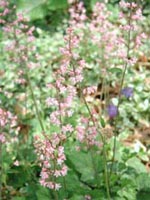Resource Library
Plant of the Week: Heucherella
The University of Arkansas System Division of Agriculture does not promote, support or recommend plants featured in "Plant of the Week." Please consult your local Extension office for plants suitable for your region.
Plant of the Week
Heucherella
Latin: x Heucherella tiarelloides

In our ongoing discussion of how new plants are developed, now is a good time to discuss the mysterious "x" and what it means. To illustrate this principle, let’s discuss the many forms of xHeucherella tiarelloides, the Heucherellas.
The "x" is a universal symbol used to denote a plant hybrid. The placement of the symbol is important. If it’s placed between the two names of a plant, that tells us that the hybrid is a cross between two species within a genus, as was the case of Dragonwing begonia we discussed last week. These are called interspecific hybrids.
But when the "x" comes before the plant name, that tells us we are dealing with an intergeneric hybrid - a cross between two different plant genera. Because the symbol seems to dangle in the stream of a sentence, non-plant people involved in editing copy do all sorts of things with the pesky "x", most often omitting it all together.
Heucherella is a cross between two members of the Saxifrage family, Heuchera x brizoides and Tiarella cordifolia. In this case, the female parent of the cross, the Heuchera (Coral Bells), is itself an interspecific hybrid - a cross between H. micrantha x H. sanguinea which are both native to wide areas of North America. Tiarella cordifolia (Foam Flower) is a woodland grower in southern Appalachian region.
The first crosses of these two genera appears to have been made before 1970 by Alan Bloom, the famous English plant breeder who developed a number of our select garden perennials.
For plants from different genera to successfully cross, they must share the same chromosome number and enough similarity in their DNA sequence to match up in enough places to create a viable seed. Intergeneric hybrids, while fairly common amongst orchids and members of the African violet tribe, are relatively rare in the plant kingdom as a whole. I know of no examples where they occurred without the helping hand of man.
Heucherellas, as intergeneric hybrids, combine the physical traits of the two parents. They retain the stoloniferous habit of the foam flowers but most have the attractive foliage of the Coral bells. The flowers have the abundance found on the foam flower parent but the size, color and shape found on coral bells. Most plants are evergreen with the foliage held close to the ground and pink or white flowers on sixteen inch long stems held in open sprays above the foliage.
Ten of the intergeneric hybrid Heucherellas have been released in the past decade due to the efforts of Oregon Nurseryman, Dan Heims at Terra Nova Nursery. Heims is a landscaper turned plant breeder who began his breeding efforts about 1990, working with the common coral bell. He was bitten by the hybridizing bug and in no time had released more than 50 selections of just coral bells and Heucherellas.
Dan’s hybridizing strategy seems to be to collect as many species of a given plant as possible and then make as many crosses as possible amongst the plants. From these crosses he grew out 1,200 to 3,000 seedlings. From these populations, he selects the ones with the best growth forms, floral and foliage characteristics for introduction. Because the plants were propagated vegetatively, he didn’t have to worry about the time-consuming task of fixing the line so it would breed true from seed.
Since his initial foray into breeding Heuchera, he has gone on to work with more than a dozen genera. But, unlike many plant breeders who enjoy the solitude of their work, Dan has a flair for publicity and marketing. He mass produced his introductions in his own tissue culture lab and quickly got them into the nursery distribution channels.
His hybrids quickly gained notoriety in horticultural circles, with one of his coral bells winning the best new perennial award in Holland in 1995. Since then, a number of his introductions have won medals at flower shows in France, Belgium, Germany, England and the United States.
Heucherellas have done best for me in a well drained organic soil. The maroon foliage types like ‘Birthday Cake’ and ‘Chocolate Lace’ will grow in full sun to light shade. The flowering types like ‘Bridget Bloom’ and the yellow foliage types such as ‘Sunspot’ should be kept in some shade. Every three or four years the plants should be dug in early spring and reset in freshly amended soil with the oldest part of the crown discarded.
By: Gerald Klingaman, retired
Extension Horticulturist - Ornamentals
Extension News - September 10, 2004
The University of Arkansas System Division of Agriculture does not maintain lists of retail outlets where these plants can be purchased. Please check your local nursery or other retail outlets to ask about the availability of these plants for your growing area.